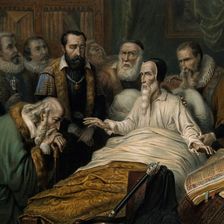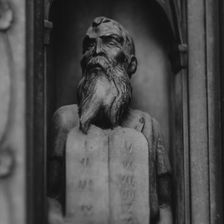Revelation 20

RevelationSteve Gregg
Steve Gregg provides an interpretation of Revelation chapter 20, which is considered a controversial chapter in the Bible. Gregg discusses the representation of the thousand-year period in the chapter, which he believes to be a symbolic representation of a lengthy period of time. He also discusses the first resurrection and the difference between physical and spiritual resurrections. Gregg believes that the binding of the devil is a symbolic representation of a long period of time when Satan's power is curtailed, and interference with the church's mission is reduced.
More from Revelation
19 of 19

Next in this series
Revelation 21 - 22
Revelation
In this text, Steve Gregg discusses Revelation 21-22 and the idea of a new heaven and earth. Gregg notes that the descent of the New Jerusalem and the
17 of 19

Revelation 19
Revelation
Steve Gregg provides an in-depth analysis of Revelation 19, discussing the fall of Babylon and the marrying of the faithful woman by God. He also touc
Series by Steve Gregg

Song of Songs
Delve into the allegorical meanings of the biblical Song of Songs and discover the symbolism, themes, and deeper significance with Steve Gregg's insig

God's Sovereignty and Man's Salvation
Steve Gregg explores the theological concepts of God's sovereignty and man's salvation, discussing topics such as unconditional election, limited aton

Gospel of Matthew
Spanning 72 hours of teaching, Steve Gregg's verse by verse teaching through the Gospel of Matthew provides a thorough examination of Jesus' life and

Isaiah
A thorough analysis of the book of Isaiah by Steve Gregg, covering various themes like prophecy, eschatology, and the servant songs, providing insight

Three Views of Hell
Steve Gregg discusses the three different views held by Christians about Hell: the traditional view, universalism, and annihilationism. He delves into

Psalms
In this 32-part series, Steve Gregg provides an in-depth verse-by-verse analysis of various Psalms, highlighting their themes, historical context, and

Ten Commandments
Steve Gregg delivers a thought-provoking and insightful lecture series on the relevance and importance of the Ten Commandments in modern times, delvin

1 Thessalonians
In this three-part series from Steve Gregg, he provides an in-depth analysis of 1 Thessalonians, touching on topics such as sexual purity, eschatology

Malachi
Steve Gregg's in-depth exploration of the book of Malachi provides insight into why the Israelites were not prospering, discusses God's election, and

2 Timothy
In this insightful series on 2 Timothy, Steve Gregg explores the importance of self-control, faith, and sound doctrine in the Christian life, urging b
More on OpenTheo

How Do We Advocate for Christian Policy Without Making the Government Interfere in Every Area of Life?
#STRask
November 20, 2025
Questions about how to advocate for Christian policy without making the government interfere in every area of life, and the differences between the mo

After the Crucifixion, was Jesus Resurrected or Rescued? Licona vs. Ally
Risen Jesus
October 8, 2025
This episode is a 2016 debate held at the University of Tennessee – Chattanooga between Dr. Michael Licona and Dr. Shabir Ally, president of the Islam

How Can I Improve My Informal Writing?
#STRask
October 6, 2025
Question about how you can improve your informal writing (e.g., blog posts) when you don’t have access to an editor.
* Do you have any thoughts or

Protestants and Catholics: What’s the Difference? With Chad Van Dixhoorn, Blair Smith, and Mark McDowell
Life and Books and Everything
November 26, 2025
How should Protestants think about the Catholic Mass? About the Eucharist? About the history and development of the papacy? In this panel discussion,

Is 1 Corinthians 12:3 a Black-and-White Tool for Discernment?
#STRask
October 27, 2025
Questions about whether the claim in 1 Corinthians that “no one can say ‘Jesus is Lord’ except in the Holy Spirit” is a black-and-white tool for disce

How Can I Showcase God’s Goodness When I’m Struggling in My Suffering?
#STRask
September 8, 2025
Questions about how to showcase God’s goodness when we’re really struggling in our suffering, an explanation of God’s response at the end of the book

How Would You Convince Someone That Evil Exists?
#STRask
November 17, 2025
Questions about how to convince someone that evil exists, whether Charlie Kirk’s murder was part of God’s plan, whether that would mean the murderer d

Corey Miller: The Progressive Miseducation of America
Knight & Rose Show
September 27, 2025
Wintery Knight and Desert Rose welcome Dr. Corey Miller to discuss The Progressive Miseducation of America. They examine how universities promote scie

Are Demon Possessions and Exorcisms in the New Testament Literal?
#STRask
December 11, 2025
Questions about whether references to demon possessions and exorcisms in the New Testament are literal, how to talk to young children about ghosts, an

How Do I Reconcile the Image of God as Judge with His Love, Grace, and Kindness?
#STRask
October 20, 2025
Questions about how to reconcile the image of God as a judge with his love, grace, and kindness, why our sins are considered to be sins against God, a

Did God Create Us So He Wouldn’t Be Alone?
#STRask
November 3, 2025
Questions about whether God created us so he wouldn’t be alone, what he had before us, and a comparison between the Muslim view of God and the Christi

Conservatism and Religious Freedom with John Wilsey
Life and Books and Everything
October 27, 2025
What is conservatism? And why does it go hand in hand with religious freedom? How should we think about the American experiment of ordered liberty? Ha

If We Don’t Need to Learn to Hear God’s Voice, How Do You Explain These Verses?
#STRask
September 11, 2025
Questions about why, if we don’t need to learn to hear God’s voice, there’s a command to earnestly desire the gift of prophecy, why we would need to l

How Does It Affect You If a Gay Couple Gets Married or a Woman Has an Abortion?
#STRask
October 16, 2025
Questions about how to respond to someone who asks, ”How does it affect you if a gay couple gets married, or a woman makes a decision about her reprod

Can You Provide Verifiable, Non-Religious Evidence That a Supernatural Jesus Existed?
#STRask
November 10, 2025
Question about providing verifiable, non-religious evidence that a supernatural Jesus existed.
* I am an atheist and militantly anti-god-belief. Ho
